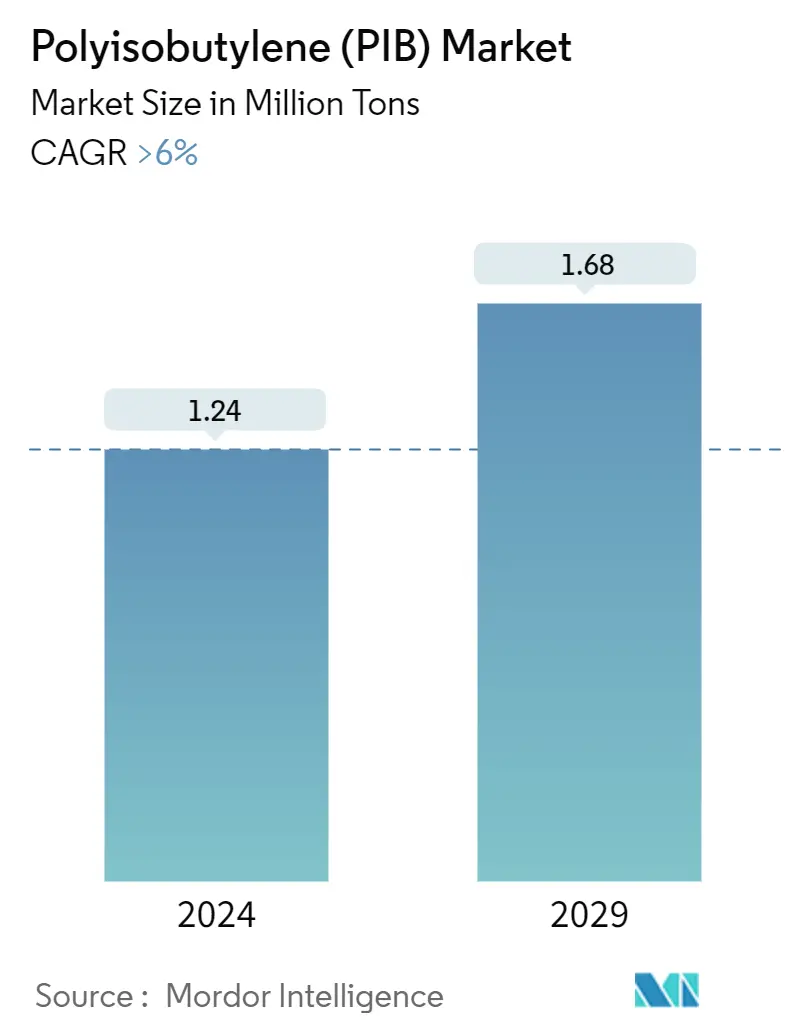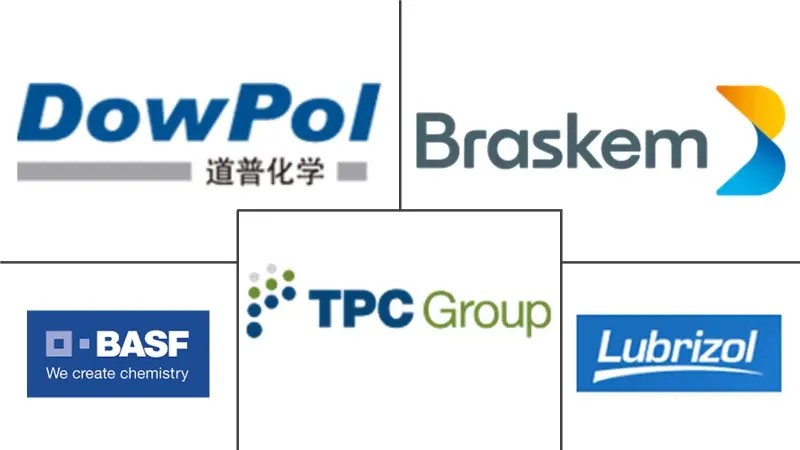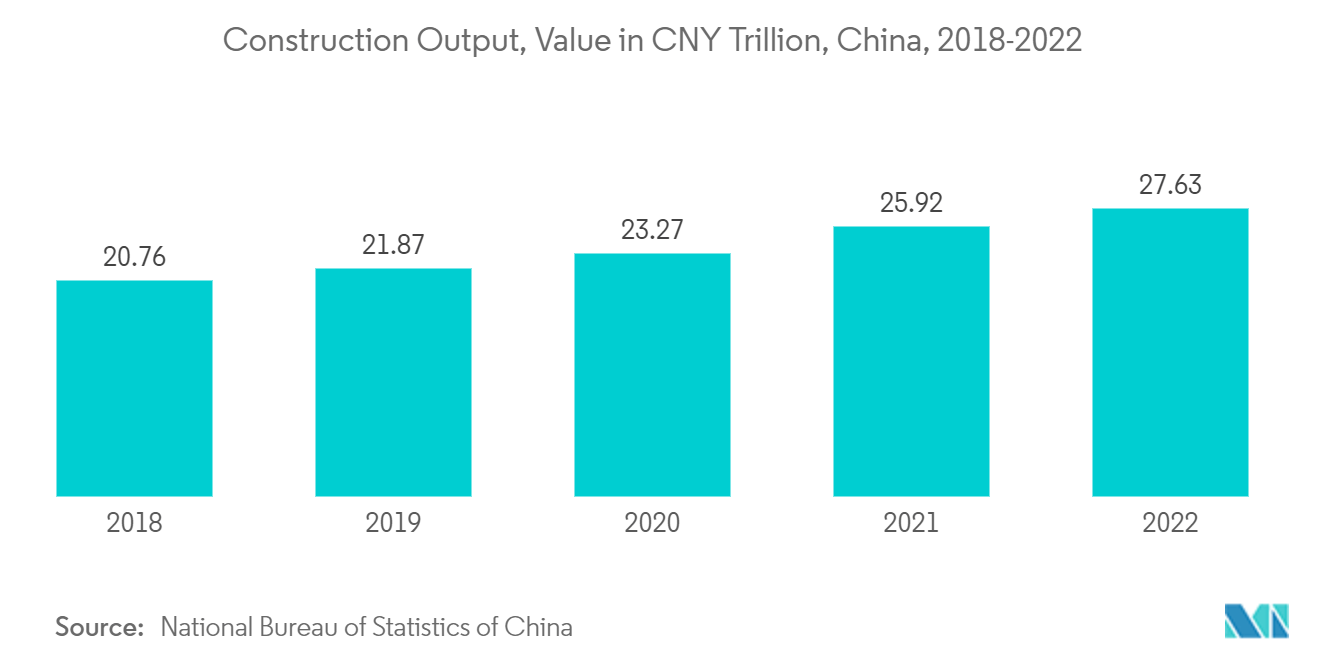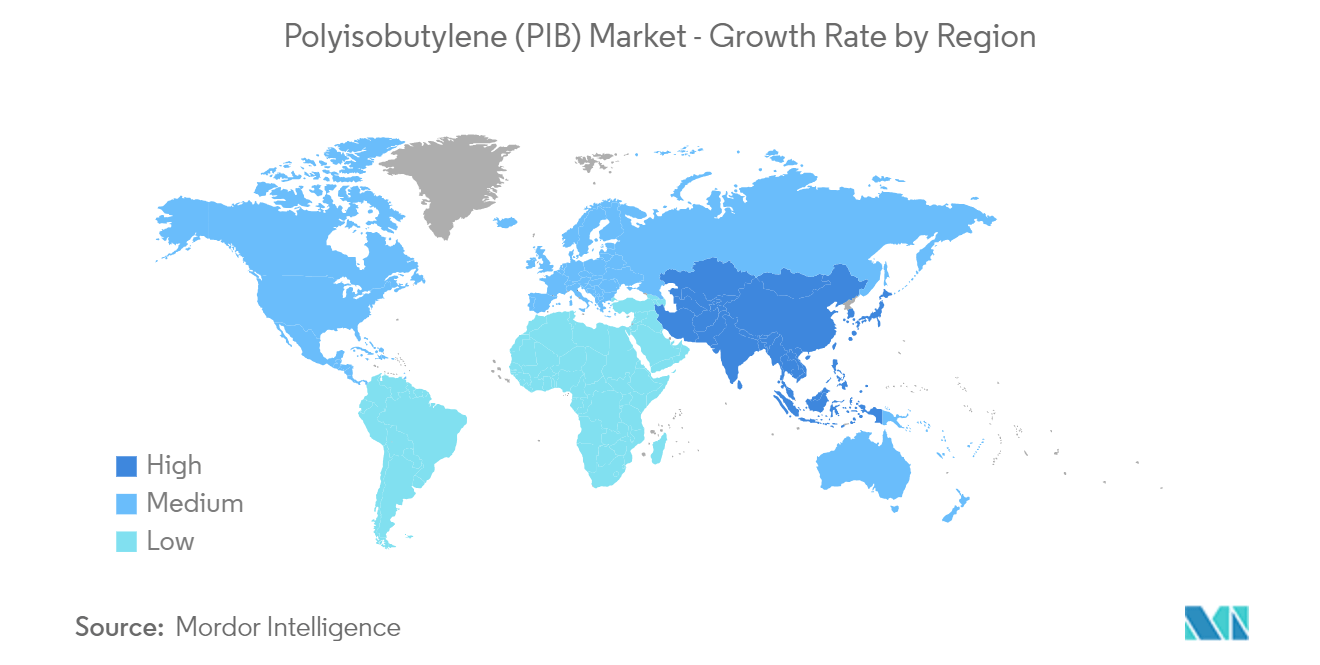Polyisobutylene (PIB) Market Size

| Study Period | 2019-2029 |
| Base Year For Estimation | 2023 |
| CAGR (2024 - 2029) | 6.00 % |
| Fastest Growing Market | Asia Pacific |
| Largest Market | Asia Pacific |
| Market Concentration | Low |
Major Players
*Disclaimer: Major Players sorted in no particular order |
Polyisobutylene (PIB) Market Analysis
The Polyisobutylene Market size is estimated at 1.24 Million tons in 2024, and is expected to reach 1.68 Million tons by 2029, growing at a CAGR of greater than 6% during the forecast period (2024-2029).
- The market was negatively impacted by the COVID-19 pandemic as there was a slowdown in production and mobility wherein industries, such as adhesives and sealants, lubricants, etc., were forced to delay their production due to containment measures and economic disruptions. Currently, the market has recovered from the pandemic. The market reached pre-pandemic levels in 2022 and is expected to grow steadily in the future.
- The major factor driving the market studied is increasing demand from the adhesives and sealants industry.
- On the flip side, the instability of polyisobutylene, being non-UV resistant, is hindering the growth of the market.
- Polyisobutylene, as a substitute for wool fat in stuffing agents for the production of leather, is expected to offer various opportunities for the growth of the market.
- Asia-Pacific region dominates the market globally, with the most substantial consumption from countries like China, Japan, South Korea, and India.
Polyisobutylene (PIB) Market Trends
Increasing Demand from Adhesives and Sealants Industry
- The adhesive and sealant industry is anticipated to witness significant demand during the forecast period. Major applications of polyisobutylene in the adhesive and sealant industry are to seal joints, to seal and protect electrical wirings, and to protect body cavities from moisture.
- Polyisobutylene is used in adhesive systems in the form of pressure-sensitive and hot-melt adhesives. It is used due to its tackiness, flexibility, and low cohesive strength, mainly in PSAs and hot-melt adhesives.
- In June 2023, Henkel announced the addition of a new adhesive manufacturing facility in China. The new manufacturing facility of Henkel Adhesive Technologies in the Yantai chemical industry park in Shandong province, China. The new plant, 'Kunpeng,’ will cost approximately CNY 870 million (USD 119 Million). The new plant will increase Henkel’s production capacity of high-impact adhesive products in China and further optimize the supply chain to meet the increasing demand from domestic and foreign markets.
- In May 2023, Jowat, the adhesive manufacturer, announced to expand its presence in Asia-Pacific with the establishment of its own adhesive center in China. The new adhesive center in Asia will have a surface area of more than 11,000 sq meters and is planned to be finished by 2023.
- Growth in residential construction in the Asia-Pacific region is expected to act as a driver for pressure-sensitive and hot melt adhesives. Polyisobutylene sealant is used for damp proofing, rubber roof repair, and maintenance of roof membranes.
- The Asia-Pacific accounted for the largest market for office construction across the globe. The reports by Cushman & Wakefield state the Asia-Pacific region is likely to incorporate office construction at an average of 120 million square feet annually till 2030. Thus, with the increasing number of office activities, the demand for polyisobutylene in office supplies will also significantly increase.
- Various construction firms consider Europe’s long future for office spaces. Also, several companies have invested in construction projects in the commercial sector, driving the demand for polyisobutylene.
- China is one of the leading countries in office space construction. The construction of office spaces such as Wuhan Fosun Bund Center T1 in China is expected to boost the market studied. Construction work for the project started in Q3 2021 and is forecasted to complete in Q4 2025.
- Also, according to the National Bureau of Statistics of China, China's construction output peaked in 2022 at a value of about USD 4.11 trillion. As a result, these factors tend to increase the market demand.
- The adhesives and sealants industry is expected to dominate the global polyisobutylene market over the forecast period.

Asia-Pacific Region to Dominate the Market
- Asia-Pacific is expected to be the dominant market for polyisobutylene during the forecast period. This is because the region dominates the market for applications such as adhesives and sealants, lubricants, fuel additives, and among others.
- In March 2023, Pidilite announced the manufacture of Jowat’s hot melt adhesive in India. The adhesives will be produced at Pidilite's manufacturing plant in Vapi, Gujarat. The company further announced that the adhesive will be manufactured under the Pidilite brand.
- Polyisobutylene is widely used in lubricants for modifying or improving the viscosity of the lubricant formulations to the desired final viscosity. The lubricants market is currently witnessing an increasing demand for high-performance lubricants owing to their better and improved properties, such as reduced flammability, reduced gear wear, and increased service life.
- Polyisobutylene is added to fuel to improve the viscoelastic property. Derivatives of polyisobutylene are used as ash-less dispersants (such as PIBSA) to minimize deposits and prevent oil thickening and formation of sludge.
- Thus, the growing automotive industry is expected to boost the market demand. China is the largest manufacturer of automobiles in the world. The country’s automotive sector has been shaping up for product evolution, with the country focusing on manufacturing products to ensure fuel economy while minimizing emissions, owing to the growing environmental concerns.
- According to OICA (The Organisation Internationale des Constructeurs d'Automobiles), automobile production and sales reached 27.021 million and 26.864 million, respectively, in 2022, up 3.4% and 2.1% from the previous year.
- Thus, rising demands from the polyisobutylene applications mentioned above are expected to drive the growth of the market in the Asia-Pacific region.

Polyisobutylene (PIB) Industry Overview
The polyisobutylene market is fragmented in nature. The major players in the studied market (not in any particular order) include BASF SE, Braskem, Dowpol Corporation, TPC Group, and The Lubrizol Corporation, among others.
Polyisobutylene (PIB) Market Leaders
-
BASF SE
-
Braskem
-
Dowpol Corporation
-
TPC Group
-
The Lubrizol Corporation
*Disclaimer: Major Players sorted in no particular order

Polyisobutylene (PIB) Market News
- September 2023: TPC Group successfully concluded the first phase of its di-isobutylene capacity upgrade, positioning itself to meet the surging global demand for di-isobutylene fueled by the widespread adoption of low global warming potential refrigerants.
- August 2023: BASF expanded its production capacity for medium-molecular-weight polyisobutenes in Ludwigshafen, Germany, by an impressive 25%, demonstrating its commitment to addressing the growing market needs.
Polyisobutylene (PIB) Market Report - Table of Contents
1. INTRODUCTION
- 1.1 Study Assumptions
- 1.2 Scope of the Study
2. RESEARCH METHODOLOGY
3. EXECUTIVE SUMMARY
4. MARKET DYNAMICS
-
4.1 Drivers
- 4.1.1 Increasing Demand from Adhesives and Sealants
- 4.1.2 Rising Demand for PIB from Transportation Sector
- 4.1.3 Other Drivers
-
4.2 Restraints
- 4.2.1 Instability of Polyisobutylene being Non-UV Resistant
- 4.2.2 Other Restraints
- 4.3 Industry Value Chain Analysis
-
4.4 Porter's Five Forces Analysis
- 4.4.1 Bargaining Power of Suppliers
- 4.4.2 Bargaining Power of Buyers
- 4.4.3 Threat of New Entrants
- 4.4.4 Threat of Substitute Products and Services
- 4.4.5 Degree of Competition
5. MARKET SEGMENTATION (Market Size in Volume)
-
5.1 Application
- 5.1.1 Tire Tubes
- 5.1.2 Adhesive and Sealants
- 5.1.3 Lubricants
- 5.1.4 Plasticizers
- 5.1.5 Fuel Additives
- 5.1.6 Electrical Insulation
- 5.1.7 Other Applications (Lube Additives, Etc.)
-
5.2 Geography
- 5.2.1 Asia-Pacific
- 5.2.1.1 China
- 5.2.1.2 India
- 5.2.1.3 Japan
- 5.2.1.4 South Korea
- 5.2.1.5 Rest of Asia-Pacific
- 5.2.2 North America
- 5.2.2.1 United States
- 5.2.2.2 Canada
- 5.2.2.3 Mexico
- 5.2.3 Europe
- 5.2.3.1 Germany
- 5.2.3.2 United Kingdom
- 5.2.3.3 Italy
- 5.2.3.4 France
- 5.2.3.5 Rest of Europe
- 5.2.4 South America
- 5.2.4.1 Brazil
- 5.2.4.2 Argentina
- 5.2.4.3 Rest of South America
- 5.2.5 Middle East and Africa
- 5.2.5.1 Saudi Arabia
- 5.2.5.2 South Africa
- 5.2.5.3 Rest of Middle East and Africa
6. COMPETITIVE LANDSCAPE
- 6.1 Mergers and Acquisitions, Joint Ventures, Collaborations, and Agreements
- 6.2 Market Share (%)**/Ranking Analysis
- 6.3 Strategies Adopted by Leading Players
-
6.4 Company Profiles
- 6.4.1 BASF SE
- 6.4.2 Braskem
- 6.4.3 Dowpol Corporation
- 6.4.4 TPC Group
- 6.4.5 The Lubrizol Corporation
- 6.4.6 Exxon Mobil Corporation
- 6.4.7 JX Nippon Oil & Gas Exploration Corporation
- 6.4.8 Kemipex
- 6.4.9 SABIC
- 6.4.10 Zhejiang Shunda New Material Co., Ltd.
- *List Not Exhaustive
7. MARKET OPPORTUNITIES AND FUTURE TRENDS
- 7.1 Polyisobutylene as Substitute for Wool Fat in Stuffing Agents for the Production of Leather
- 7.2 Other Opportunities
Polyisobutylene (PIB) Industry Segmentation
Polyisobutylene (PIB) is the polymer of isobutene, a main component of butyl rubber. Polyisobutylene is soluble in water, which makes it a universally usable polymer for a wide range of industrial applications. Polyisobutylene is used to manufacture lubricants, sealants, adhesives, fuel additives, cling-film, and among others.
The polyisobutylene market is segmented by application and geography. By application, the market is segmented into tire tubes, adhesives and sealants, lubricants, plasticizers, fuel additives, electrical insulation, and other applications (lube additives, etc.). The report also covers the market size and forecasts for the market in 15 countries across the globe.
For each segment, the market sizing and forecasts have been done on the basis of volume (tons).
| Application | Tire Tubes | |
| Adhesive and Sealants | ||
| Lubricants | ||
| Plasticizers | ||
| Fuel Additives | ||
| Electrical Insulation | ||
| Other Applications (Lube Additives, Etc.) | ||
| Geography | Asia-Pacific | China |
| India | ||
| Japan | ||
| South Korea | ||
| Rest of Asia-Pacific | ||
| Geography | North America | United States |
| Canada | ||
| Mexico | ||
| Geography | Europe | Germany |
| United Kingdom | ||
| Italy | ||
| France | ||
| Rest of Europe | ||
| Geography | South America | Brazil |
| Argentina | ||
| Rest of South America | ||
| Geography | Middle East and Africa | Saudi Arabia |
| South Africa | ||
| Rest of Middle East and Africa |
Polyisobutylene (PIB) Market Research FAQs
How big is the Polyisobutylene Market?
The Polyisobutylene Market size is expected to reach 1.24 million tons in 2024 and grow at a CAGR of greater than 6% to reach 1.68 million tons by 2029.
What is the current Polyisobutylene Market size?
In 2024, the Polyisobutylene Market size is expected to reach 1.24 million tons.
Who are the key players in Polyisobutylene Market?
BASF SE, Braskem, Dowpol Corporation, TPC Group and The Lubrizol Corporation are the major companies operating in the Polyisobutylene Market.
Which is the fastest growing region in Polyisobutylene Market?
Asia Pacific is estimated to grow at the highest CAGR over the forecast period (2024-2029).
Which region has the biggest share in Polyisobutylene Market?
In 2024, the Asia Pacific accounts for the largest market share in Polyisobutylene Market.
What years does this Polyisobutylene Market cover, and what was the market size in 2023?
In 2023, the Polyisobutylene Market size was estimated at 1.17 million tons. The report covers the Polyisobutylene Market historical market size for years: 2019, 2020, 2021, 2022 and 2023. The report also forecasts the Polyisobutylene Market size for years: 2024, 2025, 2026, 2027, 2028 and 2029.
Polyisobutylene (PIB) Industry Report
Statistics for the 2024 Polyisobutylene (PIB) market share, size and revenue growth rate, created by Mordor Intelligence™ Industry Reports. Polyisobutylene (PIB) analysis includes a market forecast outlook to 2029 and historical overview. Get a sample of this industry analysis as a free report PDF download.



